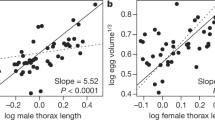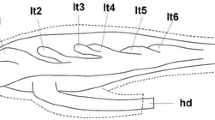Abstract
Four hypotheses about the temporal variation of the number of spermatozoa in the spermatheca of once-mated females were tested in the migratory locust, Locusta migratoria. The best fit provided a regression model that assumed a sudden drop in sperm numbers being indicative of sperm ejection by females. Thereafter, one-fifth of an average ejaculate is stored. Low numbers of sperm stored do not lead to female sperm limitation, as none of the fitness parameters measured, fertilization success, hatching success, and offspring sex ratio, were correlated with the number of sperm present. Fertilization success decreased with successive egg pods. The offspring sex ratio was slightly male biased and tended to increase throughout the laying period. By applying our sperm ejection model to an independent data set of Parker and Smith (1975), we show that the low numbers of sperm retained by the female and subsequent sperm mixing rather than direct replacement may explain the high P2 values found in this species.
Similar content being viewed by others
REFERENCES
André, C., and Lindegarth, M. (1995). Fertilization efficiency and gamete viability of a sessile, free-spawning bivalve, Cerastoderma edule. Ophelia 43: 215-227.
Birkhead, T. R., and Biggins, J. D. (1998). Sperm competition mechanisms in birds: Models and data. Behav. Ecol. 9: 253-260.
Birkhead, T. R., and Petrie, M. (1995). Ejaculate features and sperm utilization in peafowl Pavo cristatus. Proc. R. Soc. Lond. B 261: 153-158.
Boldyrev, B. Th. (1929). Spermatophore fertilization in the migratory locust (Locusta migratoria L.). Izvest. Pribladnoj Entomol. Leningrad 4: 189-219.
Bressac, C., and Chevrier, C. (1998). Offspring and sex ratio are independent of sperm management in Eupelmus orientalis females. J. Insect Physiol. 44: 351-359.
Castro, A. J., Pardo, M. C., López-León, M. D., Cabrero, M. D., and Camacho, J. P. M. (1997). Mating frequency increases somatic condition but not productivity in Locusta migratoria females. Hereditas 126: 53-57.
Castro, A. J., Pardo, M.C., López-León, M.D., Cabrero, J., and Camacho, J.P. (1998). Differential male mating frequency depending on male number in the migratory locust. Folia Biol. (Kraków) 46: 119-112.
Eberhard, W. G. (1996). Female Control: Sexual Selection by Cryptic Female Choice, Princeton University Press, Princeton, NJ.
Gage, A. R., and Barnard, C. J. (1996). Male cricket increase sperm number in relation to competition and females size. Behav. Ecol. Sociobiol. 38: 349-353.
Gage, M. J. (1991). Sperm competition risk directly affects ejaculate size in the Mediterranean fruit fly. Anim. Behav. 42: 1036-1037.
Gage, M. J. (1998). Influences of sex, size, and symmetry on ejaculate expenditure in a moth. Behav. Ecol. 9: 592-597.
Gregory, G. E. (1965). The formation and fate of the spermatophore in the African migratory locust, Locusta migratoria migratorioides Reiche and Farmaire. Trans. R. Entomol. Soc. Lond. 117: 33-66.
Hartmann, R., and Loher, W. (1974). Control of sexual behaviour pattern 'secondary defence' in the female grasshopper, Chorthippus curtipennis. J. Insect Physiol. 20: 1713-1728.
Hewitt, G. M., Mason, P., and Nichols, R. A. (1989). Sperm precedence and homogamy across a hybrid zone in the alpine grasshopper Podisma pedestris. Heredity 62: 343-353.
Lanmann, J. T. (1968). Delays during reproduction and their effects on the embryo and fetus. 1. Aging of sperm. N. Engl. J. Med. 278: 993-999.
Lessells, C. M., and Boag, P. T. (1987). Unrepeatable repeatabilities: A common mistake. Auk 104: 116-121.
Lillie, R. D. (1919). Studies of fertilization. VII. Analysis of variations in the fertilization power of sperm suspensions of Arbacia. Biol. Bull. 28: 229-251.
Mika, G. (1959). Über das Paarungsverhalten der Wanderheuschrecke Locusta migratoria migratorioides R. und F. und deren Abhängigkeit vom Zustand der Geschlechtsorgane. Zool. Beiträge Bonn 4: 153-203.
Pardo, M. C., Camacho, J. P. M., and Hewitt, G. M. (1994). Dynamics of ejaculate nutrient transfer in Locusta migratoria. Heredity 73: 190-197.
Parker, G. A., and Smith, J. L. (1975). Sperm competition and the evolution of the precopulatory passive phase behaviour in Locusta migratoria migratorioides. J. Entomol. A 49: 155-171.
Penzlin, H. (1989). Lehrbuch der Tierphysiologie, 4th ed., Gustav Fischer, Jena.
Reinhardt, K., Köhler, G., and Schumacher, J. (1999). Females of the grasshopper Chorthippus parallelus do not remate for fresh sperm. Proc. R. Soc. Lond. B 256: 2003-2009.
Reinhold, K. (1996). Biased primary sex ratio in the bushcricket Poecilimon veluchianus, an insect with sex chomosomes. Behav. Ecol. Sociobiol. 39: 189-194.
Ridley, M. (1988). Mating frequencies and fecundity in insects. Biol. Rev. 63: 509-549.
Simmons, L.W., and Kvarnemo, C. (1997). Ejaculate expenditure by male bushcrickets decreases with sperm competition intensity. Proc. R. Soc. Lond. B 264: 1203-1208.
Sokolow, A. J. (1926). Zur Frage der Spermatophorbefruchtung bei der Wanderheuschrecke (Locusta migratoria L.). DasWeibchen. Z. Wiss. Zool. 127: 608-618.
Tsubaki, Y., and Yamagishi, M. (1991). “Longevity” of sperm within the female of the melon fly, Dacus cucurbitae (Diptera: Tephritidae), and its relevance to sperm competition. J. Insect Behav. 4: 243-250.
Yamagishi, M., Itô, Y., and Tsubaki, Y. (1992). Sperm competition in the melon fly, Bactocera cucurbitae (Diptera: Tephritidae): Effects of sperm “longevity” on sperm precedence. J. Insect Behav. 5: 599-608.
Author information
Authors and Affiliations
Rights and permissions
About this article
Cite this article
Reinhardt, K., Meister, J. Low Numbers of Sperm Retained in the Spermatheca May Explain the High Values of Sperm Precedence in the Migratory Locust, Locusta migratoria (Latr.). Journal of Insect Behavior 13, 839–849 (2000). https://doi.org/10.1023/A:1007810517240
Issue Date:
DOI: https://doi.org/10.1023/A:1007810517240




